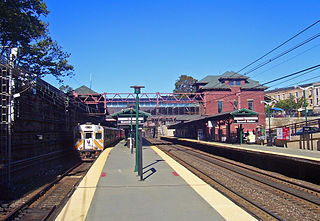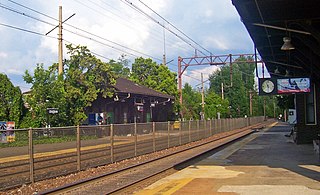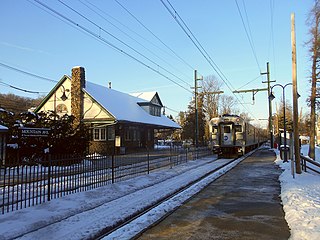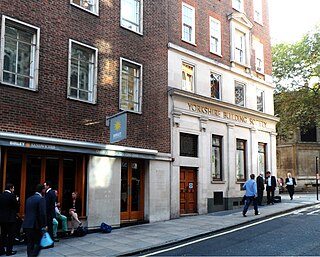
Newark is the most populous city in the U.S. state of New Jersey and the seat of Essex County. As one of the nation's major air, shipping, and rail hubs, the city had a population of 282,090 in 2018, making it the nation's 73rd-most populous municipality, after being ranked 63rd in the nation in 2000.

Essex County is a county in the northeastern part of the U.S. state of New Jersey. As of the 2018 Census estimate, the county's population was 799,767, making it the state's third-most populous county, an increase of 3.1% from the 2010 United States Census, when its population was enumerated at 783,969, in turn a decrease of 1.2% from the 793,633 enumerated in the 2000 census. In 2010, the county dropped down to third-largest, behind Middlesex County, and was one of only two counties in the state to see a decline between 2000 and 2010. Its county seat is Newark, the most populous city in the state. It is part of the New York Metropolitan Area.

The Morristown Line is one of New Jersey Transit's commuter rail lines and is one of two branches that run along the Morris and Essex Lines. Out of 60 inbound and 58 outbound daily weekday trains, 28 inbound and 26 outbound Midtown Direct trains use the Kearny Connection to Secaucus Junction and New York Penn Station; the rest go to Hoboken Terminal. Passengers can transfer at Newark Broad Street or Summit to reach the other destination. On rail system maps the line is colored dark green, and its symbol is a drum.
Route 58 is a former state highway in the city of Newark, New Jersey and nearby borough of Harrison, New Jersey. The highway ran from Orange and Hecker Streets in Newark, eastbound as a four-lane freeway across the William A. Stickel Memorial Bridge to Harrison, where it terminated at an intersection with County Route 508. The route originates as an alignment of Route 25A, a suffixed spur designated in 1939 of State Highway Route 25. The route was rechristened as Route 58 in the 1953 state highway renumbering. The highway was constructed into Interstate 280 in the 1950s, and the route persisted internally until the 1990s, when it was finally removed as a designation. A stub alignment of Route 58 remains near Hecker and Orange Streets.

Newark Broad Street is a NJ Transit commuter rail and light rail station at 25 University Avenue in Newark in Essex County, New Jersey, United States. Built in 1901-03 on the Delaware, Lackawanna and Western Railroad main line from Hoboken to Denville, Scranton and Buffalo, the station's historic architecture includes an elegant clock tower and a brick and stone façade on the station's main building.

Summit is a train station in Summit, New Jersey, served by New Jersey Transit's Morris & Essex Lines. The station sits between Union Place on the north and Broad Street on the south, with station access via either side, and between Summit Avenue on the east and Maple Avenue on the west. Constructed in 1904-05 by the Delaware, Lackawanna and Western Railroad in a mile-long open cut, it is one of the few NJ Transit stations with platforms below street level.

Brick Church is a New Jersey Transit station in East Orange, Essex County, New Jersey, United States, along the Morris and Essex Line. Service is available from this station east to Hoboken Terminal, New York Penn Station and west to Dover and Hackettstown.

Mountain Station is a New Jersey Transit station in South Orange, Essex County, New Jersey, United States, along the Morris and Essex. The station, built in 1915, has been listed in the New Jersey Register of Historic Places and National Register of Historic Places since 1984 and is part of the Operating Passenger Railroad Stations Thematic Resource.

Millburn is a New Jersey Transit station in Millburn, New Jersey along the Morristown and Gladstone lines.

Chatham is a railway station in Chatham, New Jersey. A commuter rail station, Chatham receives rail service from statewide provider NJ Transit on its Morristown Line, a branch of the Morris & Essex Lines. Trains on the Morristown Line go to both Hoboken Terminal and New York Penn Station.

Dover is an NJ Transit station in Dover, Morris County, New Jersey, United States. The station was originally built by the Delaware, Lackawanna and Western Railroad in 1901-02 and was placed on the National Register of Historic Places in 1980.

Upper Montclair is a New Jersey Transit station in Upper Montclair, New Jersey, a CDP of Montclair, New Jersey. The station is part of the Montclair-Boonton Line. The station is located between two grade level crossings on Bellevue Avenue and Lorraine Avenue, and between North Mountain Avenue and Upper Montclair Plaza parallel to the railroad, and is within steps of the Upper Montclair Business District. The station is at mile point 13.7 on the Boonton Line. Closing the grade crossing of Lorraine Avenue is being considered for safety reasons.

Mountain Avenue is a New Jersey Transit station in Montclair in Essex County, New Jersey, United States, along the Montclair-Boonton Line. The station is located on Upper Mountain Avenue, which gives the station its name.

Roseville Avenue was a transfer station on New Jersey Transit's Morris & Essex Lines in Newark, New Jersey, United States. The station was built by the Delaware, Lackawanna and Western Railroad in 1903 during a track depression to serve Newark's Roseville neighborhood. It once had two tracks on the Lackawanna mainline and two low-wall platforms, with an additional platform along the Montclair Branch. The station remained in service during most of the 20th century, until New Jersey Transit closed the station on September 16, 1984.

The New Jersey and New York Railroad (NJ&NY) was a railroad company that operated north from Rutherford, New Jersey, to Haverstraw, New York beginning in the mid-to-late 19th century. The line was originally chartered as the Hackensack and New York Railroad (H&NY) in 1856. The H&NY would eventually run from Rutherford to Hackensack, New Jersey. In 1866 under the leadership of David P. Patterson the company was rechartered as the Hackensack and New York Extension Railroad and it extended its line north of Hackensack. It later reorganized as the New Jersey and New York Railroad. The line reached the town of Haverstraw, New York by 1870, the village of West Haverstraw by 1873, and the village of Haverstraw by 1887. The NJ&NY was in turn leased for 99 years by the Erie Railroad in 1896. The NJ&NY continued to exist as an Erie subsidiary until the 1960 merger that created the Erie Lackawanna Railroad. In 1976 the Erie Lackawanna was merged with several other railroads to create Conrail. In 1983, after several years under operation by Conrail, operations of the Pascack Valley Line were transferred to New Jersey Transit Rail Operations. The segments of the two former railroad lines in New York – north of Spring Valley to Haverstraw and north of Nanuet to New City – are no longer in service.

Ampere, formerly known as The Crescent, is a defunct stop on New Jersey Transit's Montclair-Boonton Line in the city of East Orange, Essex County, New Jersey, United States. A station was first built there in 1890 to service to new Crocker Wheeler plant in the district. The stop was named in honor of André-Marie Ampère, a pioneer in electrodynamics and reconstructed as a new Renaissance Revival station in 1908. Ampere was the second stop on the branch west of Newark Broad Street Station until 1984, when the Roseville Avenue station was closed. In June of that year, the station, along with 42 others, was entered into the National Register of Historic Places. In 1986, after continuous deterioration, New Jersey Transit demolished the westbound shelter built in 1921. The agency discontinued rail service to Ampere on April 7, 1991. The entire station was demolished in 1995.

Benson Street is a former train station in a residential section of the town of Glen Ridge, New Jersey.

Fairmount Avenue is a former New Jersey Transit rail station on the Pascack Valley Line. The station was one of three rail stations in Hackensack, New Jersey, United States, and was located at Fairmount Avenue and Temple Avenue. The Essex Street and Anderson Street stations are also located in Hackensack. The station house was built in 1870 as part of the extension railroad for the Hackensack and New York Railroad on a track extension from Anderson Street in Hackensack. The line became part of the Erie Railroad in 1896 and New Jersey Transit in 1983.

The Montclair-Boonton Line is a commuter rail line of New Jersey Transit Rail Operations in the United States. It is part of the Hoboken Division. The line is a consolidation of three individual lines: the former Delaware, Lackawanna & Western Railroad's Montclair Branch, which ran from Hoboken Terminal to Bay Street, Montclair; the Erie Railroad's Greenwood Lake Division, which originally ran from the Erie's Jersey City Terminal to Greenwood Lake, NY; and the former Lackawanna Boonton Line, which ran from Hoboken to Hackettstown, New Jersey. The Montclair-Boonton line was formed when the Montclair Connection opened on September 30, 2002. The line serves 28 active rail stations in New Jersey along with New York Pennsylvania Station. It crosses through six counties, serving six stations in the township of Montclair, two in the town of Bloomfield, and one in the city of Newark. Trains along the Montclair-Boonton Line heading eastward usually originate at Hackettstown, Mount Olive, Lake Hopatcong, Dover, or Montclair State University, bound for either Hoboken Terminal or New York Penn Station. On system maps the line is colored light red and its symbol is a bird.




















